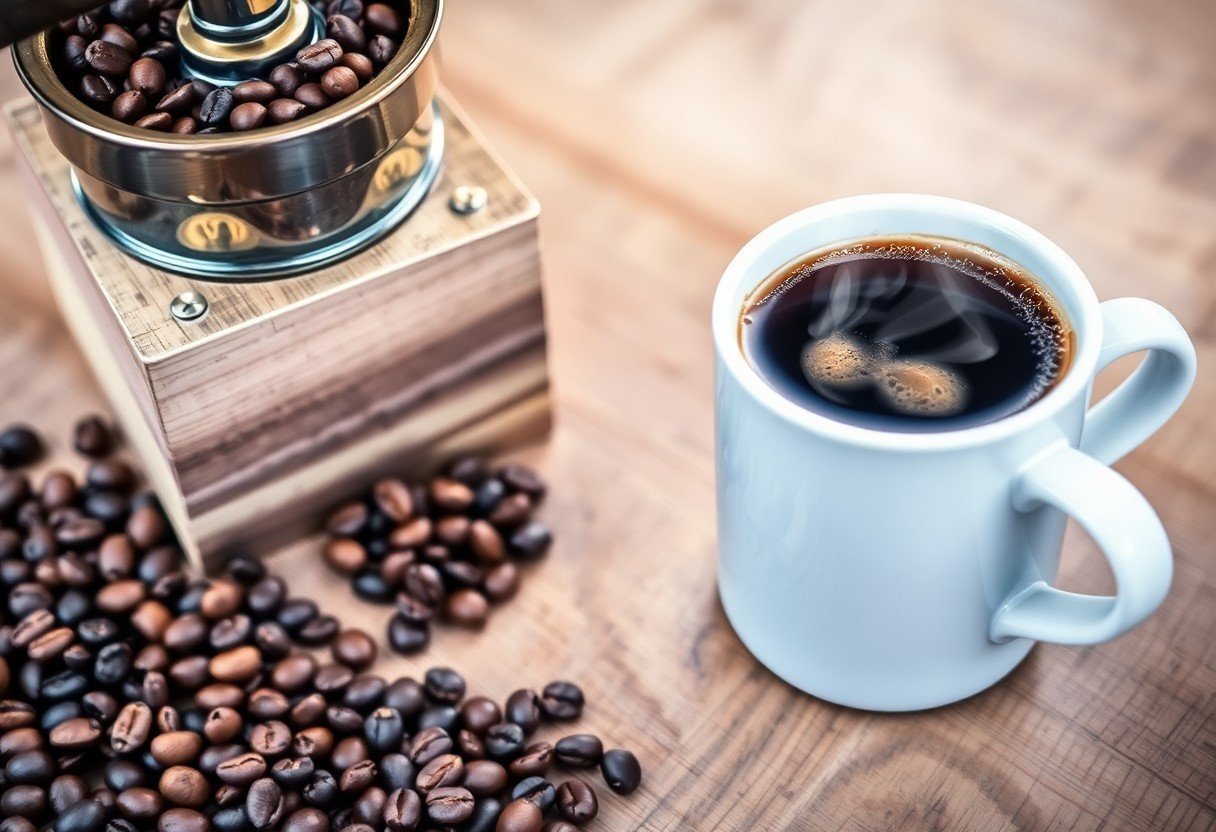Most coffee enthusiasts dream of brewing the perfect cup from beans they’ve roasted themselves. In this comprehensive guide, you will learn the necessary techniques and tips for mastering the art of self-roasting specialty coffee. From selecting the right green beans to achieving your desired roast profile, you’ll gain the knowledge and confidence needed to elevate your coffee experience. Get ready to unlock the rich, complex flavors of freshly roasted coffee right in your own kitchen!

Understanding Specialty Coffee
Before you explore the world of self-roasted specialty coffee, it’s necessary to grasp what defines specialty coffee. This term signifies high-quality beans that are cultivated with care, harvested at the optimal time, and meticulously processed. Understanding these components will significantly enhance your coffee experience, setting the stage for you to appreciate the nuances and flavors that distinguish specialty coffee from standard commercial options.
What Makes Coffee Specialty?
There’s a blend of factors that elevate coffee to the specialty level, including rigorous grading systems, careful environmental conditions, and unique processing methods. Each of these aspects contributes to the overall quality and flavor profile of the beans, making them stand out from their mass-produced counterparts.
The Importance of Coffee Origin
To truly appreciate specialty coffee, you must consider its origin. The region where coffee is grown profoundly affects its flavor, aroma, and overall character. Different altitudes, climates, and soil conditions contribute to the unique profiles of beans, making each origin a vital part of your coffee journey.
What’s often overlooked is how the specific coffee-producing region can create distinct flavors and aromas in your cup. For instance, beans from Colombia might exhibit bright acidity and sweet notes, while those from Ethiopia often showcase floral undertones and berry-like sweetness. Learning about the origins of your coffee not only enhances your tasting experience but also allows you to make informed choices that align with your personal preferences.
Factors Influencing Roast Quality
Now, understanding the various factors that influence the quality of your roast is necessary. These elements can significantly affect the flavor, aroma, and overall profile of your specialty coffee. Consider the following:
- Green coffee bean quality
- Roasting time and temperature
- Humidity levels during roasting
- Airflow in the roaster
- Cooling method post-roast
Assume that by mastering these factors, you will elevate your self-roasted coffee experience to new heights.
Green Coffee Bean Characteristics
Any variation in the characteristics of green coffee beans can significantly affect your final roast. Factors such as origin, variety, altitude, and processing method play a vital role. High-quality beans, sourced from reputable suppliers, provide a better foundation for roasting, resulting in richer flavors and aromas. Additionally, fresh beans often yield higher quality results, so always consider the age and storage conditions of your green coffee.
Roast Profiles and Their Impact
There’s a direct relationship between roast profiles and the resulting flavor notes of your coffee. Each roast profile is tailored to highlight certain characteristics in the beans, allowing you to bring out the best in your selection.
Quality roast profiles are designed with specific time and temperature parameters to develop desirable flavors while avoiding bitterness. Light, medium, and dark roasts each offer different taste experiences. A light roast, for example, often retains more acidity and fruity notes, while a dark roast may result in a bolder, more robust flavor. Understanding the intricacies of roast profiles allows you to customize your coffee to suit your personal tastes and preferences.
How to Roast Your Own Coffee
Assuming you’re ready to commence on your coffee-roasting adventure, it’s vital to understand the art and science that goes into crafting the perfect roast. For an in-depth guide, check out From Bean to Cup: The Ultimate Guide on How to Become a Coffee Roaster. You’ll gain insights on selecting beans, roasting techniques, and how to refine your approach for exceptional flavor.
Selecting the Right Equipment
One of the first steps in roasting your coffee is choosing the right equipment. You can opt for a dedicated coffee roaster, a stovetop popcorn maker, or even an oven, depending on your preference and budget. Each method offers unique advantages and flavor profiles, so consider your roasting goals and the amount of coffee you plan to produce.
Step-by-Step Roasting Process
Clearly outline your roasting process to achieve consistent results. Below is a structured process that you can follow:
Roasting Process Steps
| Step | Description |
| 1 | Preheat your roaster or cooking device. |
| 2 | Add your green coffee beans. |
| 3 | Monitor the temperature and color changes. |
| 4 | Cool the beans quickly once desired roast is achieved. |
| 5 | Store your roasted coffee properly. |
Equipment plays a significant role in your roasting experience. Depending on your setup, you may need a reliable coffee roaster, a thermometer for monitoring heat, and a timer to ensure precision. Investing in good equipment can elevate your roasting game and help you achieve a coffee that perfectly matches your taste preferences.
Essential Equipment
| Tool | Purpose |
| Coffee Roaster | Provides controlled heat for roasting. |
| Thermometer | Monitors the internal temperature of beans. |
| Timer | Tracks roasting time for consistency. |
| Cooling Tray | Rapidly cools the beans after roasting. |
Tips for Perfecting Your Roast
Unlike standard coffee roasting practices, mastering self-roasted specialty coffee requires precise techniques and a keen understanding of your beans. Here are some crucial tips to help you achieve the perfect roast:
- Experiment with different bean origins
- Monitor the roasting time closely
- Adjust heat levels gradually
- Use a reliable thermometer
- Trust your senses during tasting
After implementing these tips, you’ll find yourself on the path to coffee perfection.
Timing and Temperature Control
Even the best beans can fall flat without proper timing and temperature control. Here’s a breakdown of key factors to keep in mind:
| Initial Roast Temperature | Start between 400°F and 450°F |
| First Crack | Occurs around 400°F |
| Ideal Roast Duration | About 10 to 15 minutes |
| Final Roast Temperature | Reach up to 480°F for dark roasts |
Tasting and Adjusting Your Roast
Tips for tasting your coffee involve more than just brewing a cup. Pay attention to flavor profiles and take notes of what you like or dislike. Experiment with varying roast levels to find your optimal taste:
Your palate will guide you in making adjustments to maintain balance in acidity, sweetness, and body. Don’t hesitate to refine your roasting process by noting how changes in time and temperature impact the final flavor. This iterative approach will enhance your skills and deepen your appreciation for specialty coffee.
How to Store and Preserve Roasted Coffee
All coffee lovers know that properly storing your roasted coffee is paramount to enjoying its full flavor potential. The right storage techniques can help maintain the freshness of your beans, ensuring that each cup you brew is as delightful as intended. With a few simple practices, you can keep your roasted coffee in peak condition for an extended period, allowing you to savor the nuances of your self-roasted specialty coffee.
Best Practices for Coffee Storage
If you want to maximize the lifespan of your coffee, store it in an airtight container in a cool, dark place. Light, heat, and moisture can degrade the quality of your beans, so avoid placing your coffee near windows, stoves, or humid areas. Aim for glass or ceramic containers that seal well, as plastic can absorb odors and lead to a decline in flavor over time.
Understanding Freshness and Shelf Life
Shelf life is an important factor when it comes to enjoying your roasted coffee at its best. While freshly roasted coffee is typically at its peak flavor within the first two weeks, it can still be consumed for up to a month if it’s stored properly.
This optimal freshness period is why knowing when you’ve roasted your coffee is beneficial. After roasting, coffee begins to undergo a process of degassing, where coffee gases escape, and flavors evolve. In the first few days post-roast, your beans might taste overly sharp, but they’ll mellow out and develop a more balanced profile as time progresses. However, after about a month, the deterioration of flavor accelerates, so it’s best to consume your beans within this timeframe for the richest taste experiences.
Brewing Techniques for Specialty Coffee
Despite the variety of brewing methods available, selecting the right technique for your specialty coffee can elevate your experience significantly. Each method offers distinct flavor profiles and aromas, making it important to experiment and discover which suits your palate best. If you’re interested in learning more about sourcing and roasting coffee, check out How can I learn to source and roast specialty coffee? for valuable insights.
Methods for Extracting Flavor
On your journey to mastering self-roasted specialty coffee, you’ll want to explore various brewing methods such as pour-over, French press, or espresso. Each technique impacts the extraction process and can highlight different flavor notes in your coffee. Experimenting with grind size, brewing time, and water temperature will also help you fine-tune your brewing experience for the best taste possible.
Importance of Water Quality
Flavor plays a massive role in how your coffee tastes and is often influenced by the quality of water used during the brewing process. Poor water quality can hinder the extraction of flavor compounds, leading to bland or undesirable tastes. Using filtered or spring water, free of chlorine and impurities, can significantly improve your coffee’s overall profile and ensure you enjoy every sip.
The water you choose can either enhance or detract from the flavors in your coffee, making it important to pay attention to its quality. Hard water can contribute to unwanted mineral flavors while soft water may lead to a lack of body in your brew. Ideal water contains a balanced mineral content that promotes the extraction process without overpowering the coffee’s unique characteristics. Aiming for a total dissolved solids (TDS) range of 150–250 ppm can noticeably elevate your brewing results.
Final Words
The journey to mastering self-roasted specialty coffee is one of both art and science, offering you a gratifying exploration into flavors, aromas, and techniques. By understanding the nuances of green beans, roasting profiles, and brewing methods, you can refine your skills and elevate your coffee experience. With practice and experimentation, you will unlock the potential to create personalized cups that reflect your unique taste preferences. Embrace this adventure and enjoy the transformation of your coffee rituals into something truly exceptional.

